Lęknica
6

Overview
Łęknica, located in the Lubusz Voivodeship on the Lusatian Neisse River, is a town with a rich history and architecture that blends Polish and German cultures. The history of Łęknica is closely tied to Bad Muskau (Mużaków), to which it was annexed in 1940. A settlement developed on the right bank of the Lusatian Neisse, which after the war transformed into a new town. After the war, Łęknica was 70% destroyed, and its first inhabitants were military settlers and Poles returning from abroad. In 1969, Łęknica was granted town rights, and in 2004, the Muskau Park (Park Mużakowski) was inscribed on the UNESCO World Heritage List as a cultural heritage site. Among its monuments is the Muskau Park complex from 1815–1845, now recognized as a landscape park, and the "Belweder" palace complex from 1925, which serves as the town's cultural center. Additionally, Łęknica is distinguished by the Nad Młyńską Strugą Nature Reserve and unique monumental oak trees. The town is part of the cross-border Muskau Arch Landscape Park, important for the protection of the region's unique nature. The area of Łęknica covers 16.4 km², 65% of which is forested. Transportation in Łęknica is facilitated by National Road No. 12, which leads to the German border, and a bypass opened in 2011, easing transit traffic. The residents of Łęknica are affiliated with various religious communities, including the Roman Catholic Church and Jehovah's Witnesses. Łęknica also has a rich sports tradition, represented by the Łęknica Sports Club, which has been actively participating in regional football competitions since 1947. Interestingly, the area has been a site of intensive settlement and organizational changes over the past several decades, making it a fascinating point on the map of the Lubusz region.
Location
2025 Wizytor | All Rights Reserved